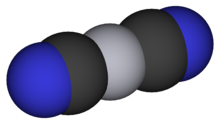سيانيد الزئبق الثنائي

| |
| الأسماء | |
|---|---|
| اسم أيوپاك
dicyanomercury
| |
| أسماء أخرى
mercuric cyanide; cyanomercury; mercury cyanide; mercury dicyanide; hydrargyri cyanidum[1]
| |
| المُعرِّفات | |
| رقم CAS | |
3D model (JSmol)
|
|
| ChemSpider | |
| ECHA InfoCard | 100.008.857 |
PubChem CID
|
|
CompTox Dashboard (EPA)
|
|
| |
| |
| الخصائص | |
| الصيغة الجزيئية | Hg(CN)2 |
| كتلة مولية | 252.63 g/mol |
| المظهر | بلورات عديمة اللون أو مسحوق أبيض |
| الرائحة | عديم الرائحة |
| الكثافة | 3.996 گ/سم³ |
| نقطة الانصهار | |
| قابلية الذوبان في الماء | 9.3 g/100 mL (14 °س) 53.9 g/100 mL (100 °س)[2] |
| قابلية الذوبان | 25 g/100 mL (ميثانول، 19.5 °س) قابل للذوبان في الإيثانول، أمونيا، گلسرين قابل للذوبان قليلاً في الإيثر غير قابل للذوبان في بنزين |
| معامل الانكسار (nD) | 1.645 |
| المخاطر | |
| NFPA 704 (معيـَّن النار) | |
ما لم يُذكر غير ذلك، البيانات المعطاة للمواد في حالاتهم العيارية (عند 25 °س [77 °ف]، 100 kPa). | |
| مراجع الجدول | |
سيانيد الزئبق الثنائي Mercury(II) cyanide، ويُعرف أيضاً بإسم السيانيد الزئبقي mercuric cyanide، هو معقد تناسقي من النيتروجين والكربون والزئبق. وهو مسحوق عديم اللون (أو أبيض)، عديم الرائحة سام ذو مذاق فلزي مر.[1] It has a melting point of 320 °C (608 °F), at which it decomposes and releases toxic mercury fumes. It is highly soluble in polar solvents such as water, alcohol, and ammonia; slightly soluble in ether; and insoluble in benzene and other hydrophobic solvents.[4] It rapidly decomposes in acid to give off hydrogen cyanide. Samples also decompose when exposed to light, becoming darker in color.[5] It reacts vigorously with oxidizing agents; fusion with metal chlorates, perchlorates, nitrates, or nitrites can cause a violent explosion.[6]
البنية الجزيئية والبلورية
At ambient temperature and ambient pressure, Hg(CN)2 takes the form of tetragonal crystals.[4] These crystals are composed of nearly linear Hg(CN)2 molecules with a C-Hg-C bond angle of 175.0° and an Hg-C-N bond angle of 177.0° (Aylett[2] gives slightly different values of 189° and 175°, respectively). Raman spectra show that the molecules distort at higher pressures. Between 16-20 kbar, the structure undergoes a phase transition as the Hg(II) center changes from 2- to 4-coordinate as the CN groups bind to neighboring Hg centers forming via Hg-N bonds. The coordination geometry thus changes from tetragonal to tetrahedral, forming a cubic crystal structure, analogous to the structure of Cd(CN)2. Due to the ambidentate nature of the CN ligands, this tetrahedral structure is distorted, but the distortion lessens with increasing pressure until the structure becomes nearly perfectly tetrahedral at >40 kbar.[7]
As in the solid state, aqueous solution, Hg(CN)2 molecules are linear.[2]
التحضير
Mercuric cyanide can be prepared by mixing yellow mercury oxide with hydrocyanic acid in the following chemical reaction[2] which is generally carried out by passing HCN gas into HgO in water. When soluble Hg(CN)2 is formed, the solution is evaporated to crystallize the product.[1]
- HgO + 2 HCN → Hg(CN)2 + H2O
Hg(CN)2 can also be prepared by mixing HgO, finely powdered Prussian blue.[2][8] In addition, it can be produced by reacting mercuric sulfate with potassium ferrocyanide in water:[8]
- K4Fe(CN)6 + 3 HgSO4 → 3 Hg(CN)2 + 2 K2SO4 + FeSO4
Another method to generate mercuric cyanide is through the disproportionation of mercury(I) derivatives. In these reactions, metallic mercury precipitates, and Hg(CN)2 remains in solution:[8]
- Hg2(NO3)2 + 2 KCN → Hg + Hg(CN)2 + 2 KNO3
التفاعلات
Mercury cyanide can be used as a promoter in the Koenigs–Knorr reaction for the synthesis of glycosides.[4] Cyanogen, (CN)2, forms upon heating dry mercury cyanide but the method is inferior to other routes:[9]
- Hg(CN)2 → (CN)2 + Hg
استخدامات سابقة
Mercuric cyanide was once used as an antiseptic, but this practice has been discontinued due to its toxicity.[10] One example of this was the treatment of syphilis: a solution of 5-10 grains in an ounce of water, painted on with a camel-hair brush, was applied to syphilitic sores of the tongue or mouth.[بحاجة لمصدر] Hg(CN)2 is also used in photography.[11] It is still used in homeopathy under the Latin name Hydrargyrum bicyanatum.
السمية
Mercury(II) cyanide is one of the most toxic poisons[بحاجة لمصدر]. Its high toxicity is due to mercury and its two cyanide groups. Because of the high solubility of Mercury(II) cyanide in water, it can absorb from skin or inhalation and cause death. Upon absorption it is readily metabolized into both cyanide and mercury, thereby resulting in the symptoms of poisoning by both agents. It is highly dangerous for the environment.
الهامش
- ^ أ ب ت "Hydrargyrum. Mercury. Part 5." http://chestofbooks.com/health/materia-medica-drugs/Manual-Pharmacology/Hydrargyrum-Mercury-Part-5.html (accessed April 1, 2009).
- ^ أ ب ت ث ج Aylett, B.J. “Mercury (II) Pseudohalides: Cyanide, Thiocyanate, Selenocyanate, Azide, Fulminate.” Comprehensive Inorganic Chemistry 3:304-306. J.C. Bailar, Harry Julius Emeléus, Sir Ronald Nyholm, and A.F. Trotman-Dickenson, ed. Oxford: Pergamon Press, 1973; distributed by Compendium Publishers (Elmsford, NY), p. 304.
- ^ http://cameochemicals.noaa.gov/chemical/3829
- ^ أ ب ت Kocovsky, P., G. Wang, and V. Sharma. "Mercury(II) Cyanide." e-EROS Encyclopedia of Reagents for Organic Synthesis. Chichester, UK: John Wiley & Sons, Ltd., 2001. http://www.mrw.interscience.wiley.com/eros/articles/rm034/sect0-fs.html (accessed April 1, 2009).
- ^ Brunton, L.T. A Text-Book Of Pharmacology, Therapeutics And Materia Medica. London: MacMillan & Co., 1885.
- ^ NOAA, Office of Response and Restoration, CAMEO Chemicals. "Chemical Datasheet: Mercuric Cyanide." NOAA. http://cameochemicals.noaa.gov/chemical/3829 (accessed April 2, 2009).
- ^ Wong, P.T.T. J. Chem. Phys. 1984, 80(12), 5937-41.
- ^ أ ب ت Miller, W.L. Elements of Chemistry: Organic chemistry, 5th ed. New York: John Wiley & Sons, 1880, p. 100.
- ^ Brotherton, T.K.; Lynn, J.W. Chemical Reviews 1959, 59(5), 841-883, 844-846.
- ^ Benaissa, M.L.; Hantson, P.; Bismuth, C.; Baud, F.J. Intensive Care Med. 1995, 21(12), 1051-1053.
- ^ "Cyanides, Cyanide Oxides and Complex Cyanides." http://www.dncustoms.gov.vn/web_eglish/bieu_thue/E_HTM/E2837.HTM (accessed April 30, 2009).
